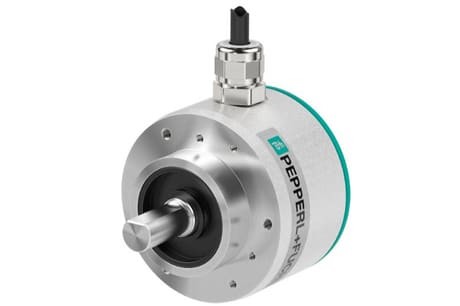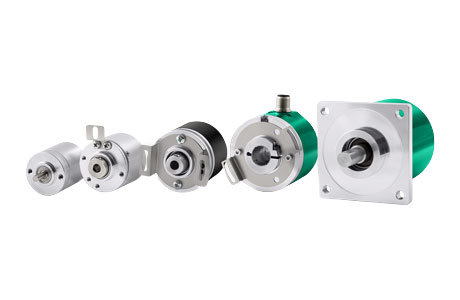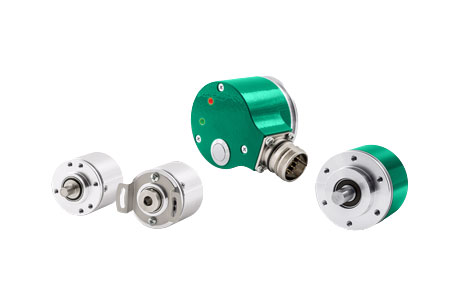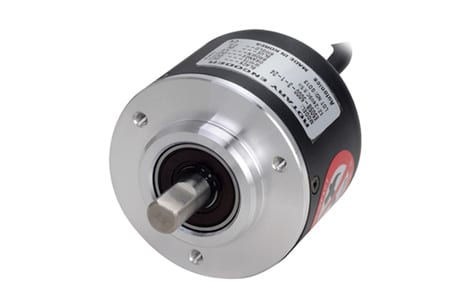Rotary Encoder Basics
A rotary encoder is a device that translates the rotation of a shaft into an electrical signal. It is used to measure and provide feedback on shaft rotation, giving information about the position or speed. This feedback is important for controlling machinery like motors, conveyors, and robots to ensure accurate operation.
Rotary encoders are categorized as absolute and incremental. Incremental encoder give pulses for each rotation, while absolute encoders provide a unique code for each position. They are widely used in different industries and applications, and there are many options to choose from based on specific needs.
Rotary Encoder Types
There are two main types of rotary encoders: incremental and absolute encoders.
Incremental Rotary Encoders: Incremental encoders generate pulse signals as the shaft rotates, conveying relative position or movement information. Unlike absolute encoders, they do not provide absolute position data, but instead track changes in position or movement.
As a result, incremental encoders are frequently utilized for speed and distance measurements. Incremental encoders are useful in applications that require relative motion information, such as monitoring rotational speed or measuring linear distance traveled. They provide valuable data for tasks that do not require absolute position information.
Absolute Rotary Encoders: It provide a unique digital code or value for each position of the shaft within a full revolution. They can directly determine the absolute position of the shaft without the need for a reference point. Absolute encoders are used in applications where precise positional information is required, such as robotics, CNC machines, and industrial automation.
Rotary encoders can be categorized based on the sensing technology they use, such as optical, magnetic, or capacitive. Each technology has its own benefits, like better precision, accuracy, durability, and proper for different environments. This provides a variety of options to choose from based on the specific needs of the application.
Rotary Encoder Working Principle
A rotary encoder’s working principle involves converting rotational motion into electrical signals. Let’s break down the working principle in a simpler way:
Optical Rotary Encoder:
An optical rotary encoder has a spinning disc with clear and dark sections and a light source on one side. Sensors on the other side detect the light passing through the sections as the disc rotates. The changing pattern of light and darkness creates electrical pulses. The number of pulses matches the disc’s sections, giving information about the shaft’s rotation or movement.
Magnetic Rotary Encoder:
A magnetic rotary encoder measures rotation using a magnet or changes in a magnetic field. It has a magnet or magnetic strip attached to the rotating shaft. Sensors detect the changes in the magnetic field caused by the rotating magnet.
As the magnet moves past the sensors, these changes are converted into electrical signals. These signals give information about the position or movement of the shaft.
Capacitive Rotary Encoder:
It measures rotation by detecting changes in capacitance. They have electrodes or plates that form a capacitor with a rotating shaft or a target attached to it. As the shaft rotates, the distance between the electrodes or the dielectric constant changes, affecting the capacitance. These changes in capacitance are converted into electrical signals, providing information about the rotational position or movement of the shaft.
Rotary Encoder Applications
Industrial Automation and Robotics: Rotary encoders enable accurate position and speed control, making them essential in industrial automation and robotics.
Automotive: In the automotive industry, rotary encoders measure gear position and facilitate engine speed control.
Consumer Electronics and Gaming: They are employed in consumer electronics devices to control cursor movement and gaming peripherals such as joysticks.
Aerospace and Defense: Rotary encoders find use in aircraft control systems and navigation systems for military vessels.
Machine Tool Industry: They play a crucial role in machine tools, precisely controlling the movement of cutting tools.
Textile and Packaging Machinery: Rotary encoders ensure the precise positioning of materials in textile and packaging machinery.
Medical Equipment: Encoders contribute to accurate component movement control in medical devices like CT scanners and MRI machines.
Elevators and Escalators: Rotary encoders are employed in elevators and escalators for smooth and safe movement.
Renewable Energy: They play a vital role in the wind turbine industry, measuring position and speed to optimize turbine operation.
How Rotary Encoder Works?
Rotary encoders convert the spinning of a shaft into electrical signals to measure position, speed, or direction. Here’s a simplified explanation of how rotary encoders work:
Encoder Disc: The encoder consists of a disc mounted on the rotating shaft. The disc typically has alternating transparent and opaque segments or a patterned code.
Light Source and Sensors: In optical rotary encoders, a light source (usually an LED) shines light onto the encoder disc. sensors, positioned on the opposite side of the disc, detect the intensity of light passing through the transparent segments.
Light Intensity Changes: The disc spins, causing the transparent and opaque segments to pass between the light source and sensors. This results in changes in the intensity of light detected by the sensors.
Signal Generation: The changes in light intensity are converted into electrical signals. In incremental encoders, the signal generated is in the form of pulses, with each pulse representing a specific amount of rotation. In absolute encoders, the electrical signals correspond to a unique digital code for each position of the shaft.
Output and Processing: The generated electrical signals are then processed and utilized by a control system for various applications. The signals can be used to determine the position, speed, or direction of the rotating shaft.
Rotary Encoder Troubleshooting and Maintenance
Here’s a concise explanation of rotary encoder troubleshooting and maintenance:
Troubleshooting:
- Check power and connections.
- Clean the encoder following manufacturer guidelines.
- Check if the rotary encoder is properly aligned and securely mounted.
- Inspect signal wiring for damage or loose connections.
- Monitor signal output using measurement tools.
- Check alignment and detection of the reference mark.
- Inspect internal components for damage or wear.
- Consult manufacturer documentation for guidance.
- Consider replacement or repair if necessary.
Maintenance:
- Regularly clean the encoder to remove dust and debris.
- Check for proper mechanical alignment and mounting.
- Inspect signal wiring for wear or damage.
- Monitor environmental conditions like temperature and humidity.
- Follow manufacturer maintenance guidelines.
- Keep records of maintenance activities.
Rotary Encoder Selection Guide
When selecting a rotary encoder, it’s important to follow these guidelines:
Application Considerations: Determine the specific requirements of your application, including resolution, accuracy, operating speed, size, mounting options, and mechanical togetherness.
Type of Encoder: Choose between absolute & incremental encoder based on your application needs. Incremental encoders provide relative position information, while absolute encoders offer absolute position information.
Sensing Technology: Select the appropriate sensing technology for your application, such as optical, magnetic, or others. Consider factors like durability, resolution, and environmental propriety.
Electrical Output and Interface: Determine the required electrical output type, such as digital, analog, or both. Ensure similarity between the encoder’s interface and your system.
Environmental Considerations: Assess the operating temperature range, humidity levels, and potential exposure to dust, moisture, vibrations, shocks, or electro magnetic interference.
Installation and Maintenance: Evaluate the ease of installation and integration into your existing system. Consider the availability of technical support, documentation, spare parts, and the overall maintenance requirements of the encoder.
Cost Considerations: Consider your budget and balance desired features with cost constraints. Evaluate the long-term benefits and return on investment of the chosen encoder.
Comparison and Evaluation: Compare different encoder models and manufacturers based on the identified criteria. Seek recommendations from experts or consult with suppliers if needed.
Final Selection: Make an informed decision based on the evaluation and select the most suitable rotary encoder for your application.
Following these guidelines ensures that the rotary encoder you choose meets your needs and performs effectively in your application.
Rotary Encoder Manufacturers
Omron, Pepperl Fuchs, Autonics, Leuze, Sick, Baumer, HEIDENHAIN etc.,
When choosing a manufacturer for rotary encoders, it is crucial to evaluate factors like product quality, reliability, and alignment with specific application requirements. Comparing different manufacturers will aid in identifying the one that aligns best with your needs.
Conclusion
In Conclusion, rotary encoders are important devices used in various industries. They convert the spinning motion of a shaft into electrical signals, allowing us to measure and control position, speed, and direction.
Optical encoders use light changes, magnetic encoders use magnetic fields, and capacitive encoders use capacitance changes.
Understanding how rotary encoders work, their types, and how to troubleshoot and maintain them ensures their optimal performance and longevity. Rotary encoders are crucial in fields like automation, cars, electronics, and more, as they provide accurate information and precise control. They have contributed to many technological advancements we see today.















